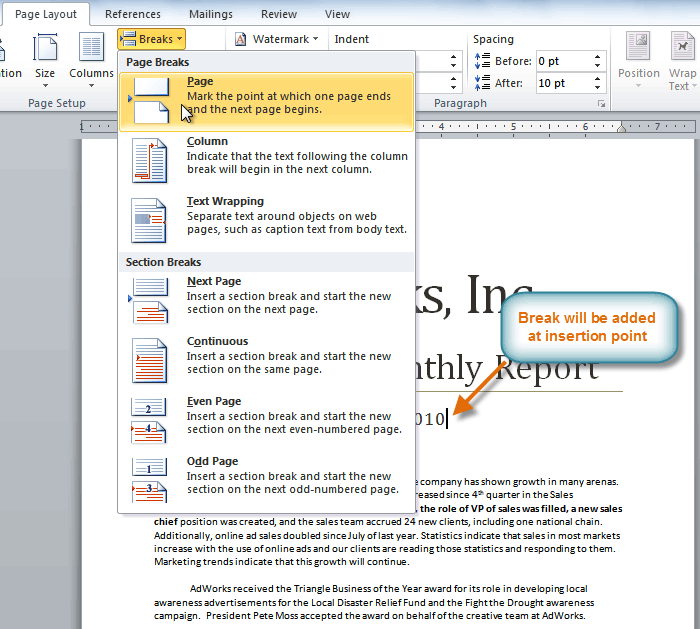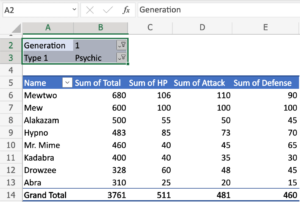Crafting Document Structure: A Comprehensive Guide to Adding Breaks in Microsoft Word 2010

Introduction:
In the realm of document creation, Microsoft Word 2010 offers a versatile set of tools for enhancing document structure and formatting. Among these tools, the ability to insert breaks plays a crucial role in creating well-organized and visually appealing documents. In this extensive guide, we will explore the intricacies of adding breaks in Microsoft Word 2010, unraveling their functionalities, customization options, and best practices for achieving a polished and organized document layout.
I. Understanding Breaks in Word 2010:
- Definition and Purpose:
- Breaks in Word 2010 are used to control the flow and layout of text within a document. They allow users to create clear distinctions between different sections, control page breaks, and manage the arrangement of text and objects.
- Types of Breaks:
- Word 2010 provides various types of breaks, including page breaks, section breaks, and column breaks. Each type serves a specific purpose in enhancing document structure and readability.
II. Accessing Breaks Options:
- Page Layout Tab:
- Access the breaks options from the Page Layout tab in Word 2010. The Page Setup group contains tools for inserting different types of breaks.
- Breaks Panel:
- The Breaks panel provides quick access to different break options. Users can choose from a variety of breaks, depending on their document formatting needs.
III. Inserting Page Breaks:
- Manual Page Breaks:
- Insert manual page breaks to force content to start on a new page. This is useful for beginning a new section or chapter, ensuring a clean separation between different parts of the document.
- Continuous Section Breaks:
- Use continuous section breaks to create breaks without starting a new page. This is beneficial for dividing content into distinct sections while maintaining a continuous flow.
IV. Managing Section Breaks:
- Next Page Section Breaks:
- Insert next page section breaks to start a new section on the next page. This is commonly used for changing page orientation, headers, footers, or other formatting elements.
- Continuous Section Breaks:
- Utilize continuous section breaks to create breaks without starting a new page. This allows for seamless transitions between different sections of the document.
- Even/Odd Page Section Breaks:
- Apply even or odd page section breaks to control the layout of facing pages. This is beneficial for documents that will be printed and bound, ensuring a consistent appearance.
V. Adding Column Breaks:
- Creating Multi-Column Layouts:
- Insert column breaks to create multi-column layouts within a section. This is useful for newsletters, brochures, or any document requiring a non-traditional column structure.
- Balancing Columns:
- Adjust column breaks to balance the distribution of content across columns. Word 2010 provides tools for fine-tuning column layouts to achieve a visually balanced appearance.
VI. Customizing Breaks for Tables and Objects:
- Table Layout Breaks:
- Insert breaks within tables to control the layout of rows and columns. Breaks can be applied to ensure proper placement of content within complex tables.
- Object Wrapping Breaks:
- Customize breaks for objects, such as images or shapes, to control how text flows around them. Breaks help achieve precise placement and formatting of objects within the document.
VII. Navigating and Deleting Breaks:
- Navigating Breaks:
- Use navigation tools to move between breaks within the document. This is helpful for reviewing and adjusting the placement of breaks as needed.
- Deleting Breaks:
- Easily delete breaks when necessary. Deleting breaks allows for document adjustments and ensures a fluid and cohesive layout.
VIII. Formatting Headers and Footers with Breaks:
- Different Headers and Footers:
- Utilize section breaks to create different headers and footers for various parts of the document. This is valuable for creating professional documents with varied formatting in different sections.
- Linking Headers and Footers:
- Link headers and footers between sections to maintain consistency. Word 2010 provides options to link or unlink headers and footers based on document requirements.
IX. Advanced Break Techniques:
- Nested Section Breaks:
- Experiment with nested section breaks to create complex document structures. This advanced technique allows for highly customized layouts and formatting.
- Document Navigation and Table of Contents:
- Leverage breaks for document navigation and table of contents. Well-placed breaks assist in creating an organized and easily navigable document structure.
X. Collaborative Document Editing with Breaks:
- Sharing Document Templates:
- Collaborate with others by sharing document templates with predefined breaks. This ensures that collaborators adhere to consistent document formatting standards.
- Managing Collaborative Edits:
- Collaborators can navigate and edit sections independently thanks to breaks. This facilitates collaborative editing while preserving the overall document structure.
XI. Document Accessibility and Breaks:
- Consistent Break Usage:
- Maintain consistent break usage for improved document accessibility. Clear and organized document structure benefits users with visual or cognitive impairments.
- Alt Text for Accessibility:
- Add descriptive alt text for images and objects affected by breaks. This enhances accessibility by providing meaningful descriptions for users with visual impairments.
XII. Mastering Break Techniques:
- Continuous Learning:
- Mastery of break techniques involves continuous learning and exploration of advanced functionalities for optimal document layout.
- Community and Online Resources:
- Engage with the community and explore online resources, tutorials, and forums to stay updated on the latest break features and best practices.
XIII. Conclusion:
- Creating Structured and Polished Documents:
- By mastering the art of adding breaks in Microsoft Word 2010, users can create structured and polished documents that enhance readability and visual appeal.
- Efficient Document Formatting:
- Striking the perfect balance between functionality and aesthetics, Word 2010’s break features empower users to create documents that are well-organized, visually appealing, and optimized for various formatting requirements.
As you embark on the journey of using breaks in Microsoft Word 2010, you unlock the potential to create documents that stand out with a clear and organized structure. Embrace the diverse features, experiment with creative layouts, and empower yourself to produce documents that seamlessly blend structure and visual appeal for an enhanced reader experience.







